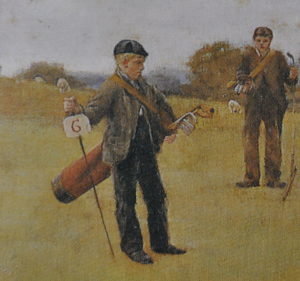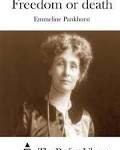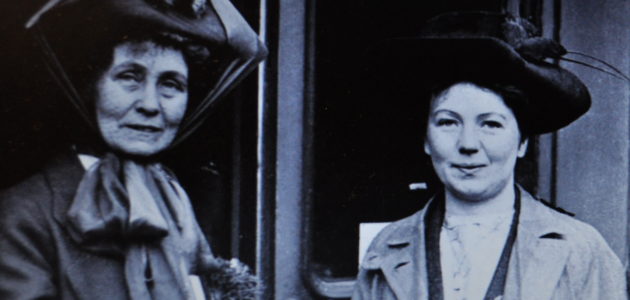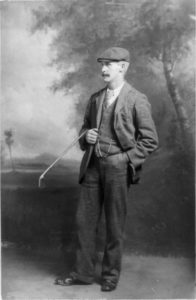Suffragettes take battle onto golf course
The Spring of 1913 saw women in Britain take to the golf course as they had never done before. In the dead of night, they sabotaged the greens at some of the country’s finest courses as part of the Suffragette Movement’s latest campaign to draw attention to their ‘Votes for Women’ cause at prominent sporting venues.
Led by Emmeline and Christabel Pankhurst, the activists carved-out huge letters in the greens in order to bring disruption to the gentleman’s game of golf. Their messages were short and to the point: “Votes for Women”; “Justice before Sport”; and “No votes, No golf”. When not using spades and garden trowels, they resorted to destructive acid to burn messages into the grass. Flags in the holes were replaced with purple flags, representing the Suffragette Movement’s sympathy colours of purple, green and white. Rousing messages were then pinned to them. The Mid-Surrey Club at Richmond was among the targeted courses near London.
At the Derby Day races, one such demonstration ended in tragedy with the death of Emily Davison. She had tried to halt the King’s horse, “Amner” but was fatally injured after being trampled under the horses hooves. The news sparked world attention for the “Votes for Women” campaign.
The Derby was not the only sporting venue where the women of the Suffragette Movement made their voices heard. In the summer of 2013, they caused havoc at football grounds, the hallowed tennis turf of Wimbledon, as well as to some of Britain’s most cherished golf courses.
Their antics became front page news. And not just in Britain. In America, Henry Leach of the ‘American Golfer’ followed the women’s ghastly golf course actions intrepidly. He and many other gentleman golfers no doubt fearful of such wild notions wafting across ‘The Pond’.
The American Golfer, 6th October 1912
“To all the many and exasperating difficulties of the game, we are now threatened with a new one in the form of suffragette raids on our golf courses while the players are busy upon them. In a sense they have begun at the top for the first course to receive their unwelcome attentions has been the private one of King George at Balmoral in Scotland, the King himself being in residence at his Highland castle at the time.”
A few weeks after the Royal incident, the Prime Minister, Mr Asquith; Home Secretary, Mr McKenna; and, on a separate occasion, Mr Winston Churchill, were also accosted during peaceful rounds of golf in Scotland. A heated verbal exchange ensued between the women and the ministerial golfers over the suffragette, Mrs Leigh who had been imprisoned in Dublin and was now on hunger-strike.

When policemen ran onto the course to arrest the two women, the situation got even more out of hand. The verbal attack became physical, so much so, that the caddies were requested by the Home Secretary to assist in the matter. However, the caddies failed to respond. Instead they preferred to take enjoyment from the struggles before them seeing it as a pleasant change from their routine work. Or, at least, that’s how the story goes.
As the Suffragettes’ actions became more militant and more golf courses were targeted, Henry Leach’s tone became notably harsher.
The American Golfer, March 1913
“At the present time, they have hit upon an original idea in destruction and are now waging a war in different parts of the country, which is most alarming to all who are associated with the game. You may remember that lately I told you of their attack on the King’s courses and likewise of how they have given the Prime Minister and other members of the Cabinet a very bad half hour while the game was being played by these great men. It is somewhat peculiar that they should thus wage war upon golf considering that it has become the favourite recreation of their own sex; but there it is, one more example of the unreasonableness of women.”
“We are not fighting you because you play golf …”

Emmeline Pankhurst
The American Golfer, April 1913
“Mrs Pankhurst made a speech in a London theatre soon after the damage was done, in which she referred to the attack they were making on golfers. “We are not fighting you because you play golf”, she shouted out to the men in the audience. “We are not fighting you at all, but trying to stir you up. Tell us you sympathise with us. We are determined, even at the price of your sympathy, to stir you up to do something.” Mrs Pankhurst added that the previous weekend she had been staying in a quiet country house and, while there, had been rung up on the telephone by some enthusiastic members of golf clubs, some of whom threatened that if these new guerrilla tactics continued, they would have to turn out the lady members of their clubs.”
It would appear that these expulsion threats made the women even more determined. They replied with a series of bombs and explosions including an attack on a house under construction near Walton Heath Golf Club in Surrey. It was the future home of the Chancellor of the Exchequer, Mr Lloyd George, who had become a keen golfer at this time. He decided to have a house built near the golf course. Although he didn’t actually own the property when the explosion went off, the resulting damage and headline news had the necessary impact for the women’s campaign.
Villagers keep night-watch at Open venue
The Open Championship venue of Royal Liverpool Club at Hoylake was considered to be a likely target for the Suffragettes’ next attack that Summer. Sensibly the club had taken the precaution of calling upon the local village community to assist them in the protection of the course during the run-up to what was expected to be the biggest Championship ever. The club had the good fortune of having the sympathy of the local people who enjoyed free use of the course at designated times and for which the club also donated prizes for an annual competition. After the successful night-guarding of the course by volunteer village watchers, the club increased their playing privileges and their annual prize donation in recognition of their services to the club. Thankfully, the Open Championship went ahead as scheduled without disturbance.
Legendary golfer JH Taylor gets ‘lucky’ at Hoylake
A certain John Henry Taylor must have also been truly grateful to the villagers for their sterling work in guarding the venue that year. The golf hero of his generation, JH Taylor had already won four Open Championship titles and had been runner-up on five occasions. In 1913, he lifted his fifth and final title at Royal Liverpool GC in glorious fashion eight-shots ahead of Ted Ray.
Incidentally, JH Taylor (pictured above) was the professional at a club near London from 1899 until his pension in 1946. Now this is where the golf history of that period gets even more interesting. The club where Taylor worked was … Royal Mid-Surrey. In fact, he also designed this fine golf course. One cannot begin to imagine how outraged he must have felt when the suffragettes mutilated ‘his’ greens during their golf campaign.
But, if you think about it, Taylor was also a lucky golfer. If Emmeline Pankhurst and her followers had been successful in gaining access to the famous Royal Liverpool Golf Club in the Summer of 1913, then the Open Championship may not have taken place that year. In which case, JH Taylor may never have become Open Champion for the fifth time. Even though he did finish second for the sixth time in his career the following year, when he was three shots behind his old rival Harry Vardon, it was to be the last Open until 1920 due to the outbreak of World War One.
It’s fascinating to realise that amidst the end-of-war celebrations in 1918, the first British women also enjoyed the right to vote that year.
Buried secrets
In my early golf days in England, I had the privilege of playing at a number of these great courses. Little did I know then of the secrets buried beneath their greens. Yet, that of course is one of the pleasures of this wonderful game – to ponder upon the players who have strolled the fairways and putted the greens over the past century ….
Wendy Hoad
Nice to know …
Long-living golfers: The legendary JH Taylor is another example of the ripe-old age golfers often reach. Born 19th March 1871, he died on 10th February 1963, aged 91.
First votes for women: In 1918, the first women in Britain were given the right to vote. Alas, Emmeline Pankhurst could only enjoy the privilege for a few years. She died in London on 14th June 1928, aged 69. READ MORE about the 100 year celebrations in ‘Early golfers and suffragettes’.
Bastille Day: Emmeline Pankhurst was born in Manchester on 14th July 1858. The storming of the Bastille, a turning point of the French Revolution, took place on 14th July 1789. One wonders how these historical epic events in France inspired the young Emmeline in her fight for women’s rights …
The Iron Lady: Seven years after the Suffragette Movements’ year of glory, Margaret Hilda Roberts was born on 13th October 1925. She married and became Mrs Margaret Thatcher pursuing a career in politics with the Conservative Party. In 1975, she became party leader. Then in May 1979, she made history when she was elected Britain’s first female Prime Minister. Emmeline Pankhurst would have been proud of her. Who knows, perhaps the ‘Iron Lady’, as she was nick-named, had been inspired by the Pankhurst sisters to get into politics? Margaret Thatcher died on 8th April 2013, aged 87. There is a fascinating golf story about ‘The Iron Lady’, but that’s a tale for another day …
You can read more about the Pankhurst sisters HERE – a fascinating read for males and females!
MAIN PHOTOGRAPH: Two of the Pankhurst sisters, Emmeline (left) and Christabel. BELOW: Typical caddies of this era. The legendary five times Open Champion JH Taylor. With thanks to the Imperial War Museum/Wikipedia.

